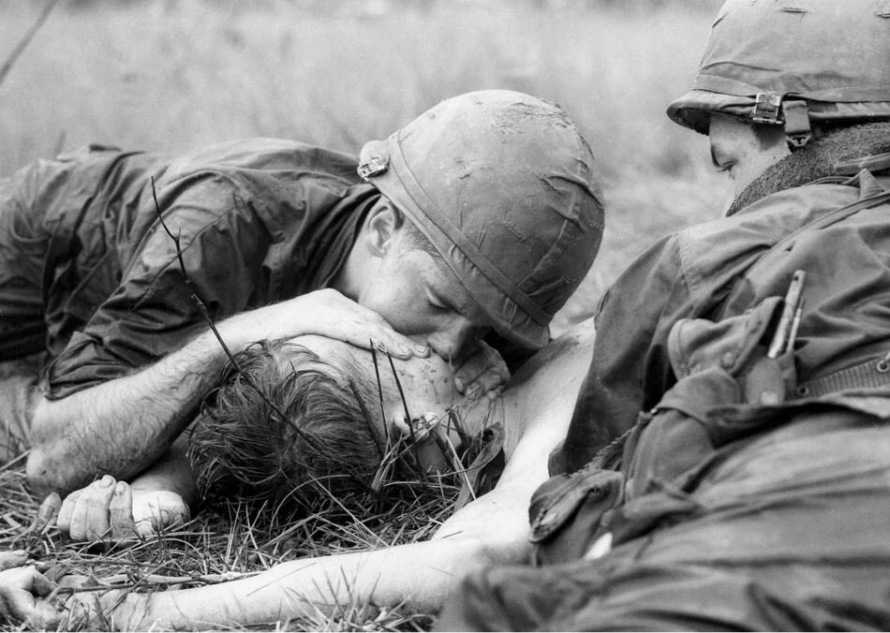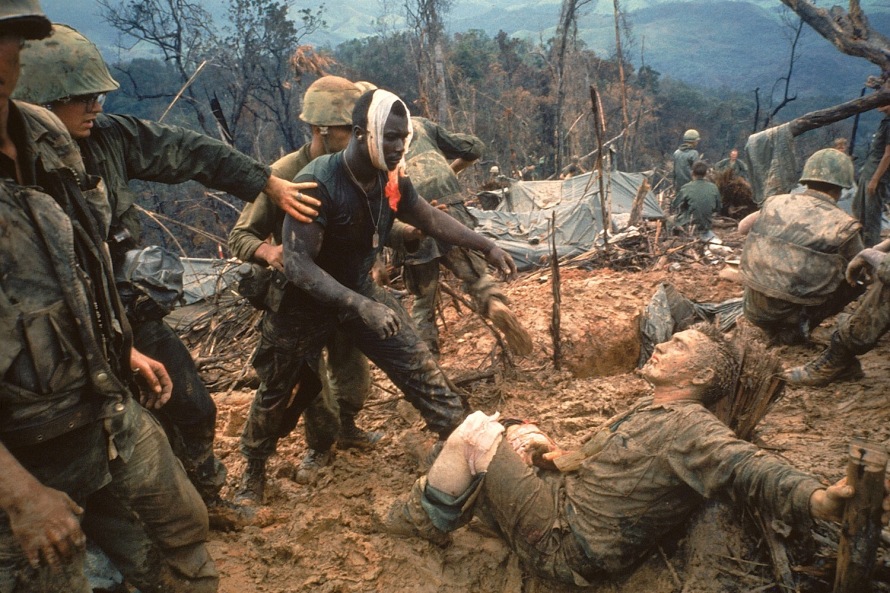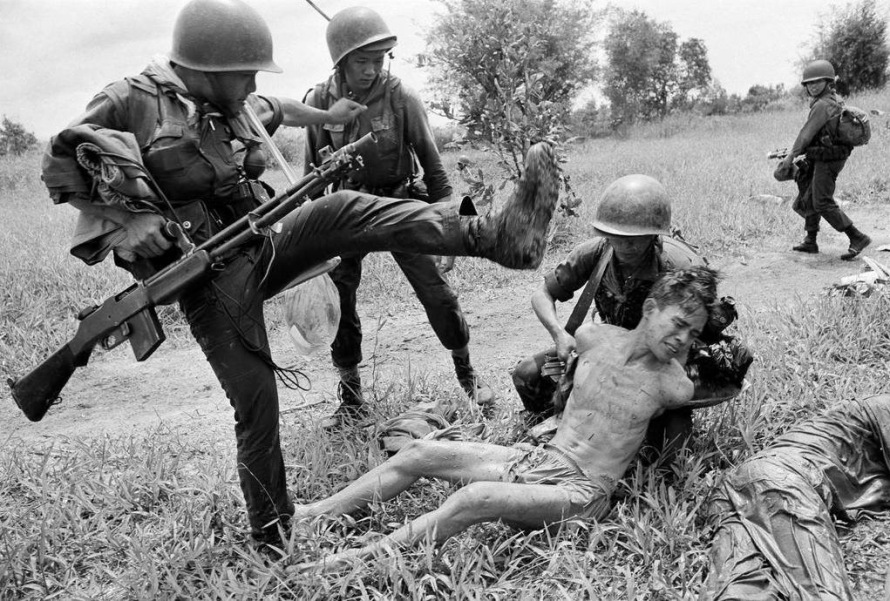As you saw in our last, most efficient post ever (less than a hundred words; I think this one will make up for it), we spent a few days at the beach.
I love going to the beach. It’s the only environment where I feel good about doing nothing all day. Everywhere else I go, I feel like I must be active; must do something productive with my time. Incredible guilt ensues if I don’t. But at the beach, I can just chill and I’m not troubled. Becci, however, isn’t such a big fan of the beach life. She hates the sun and the heat. She was a good sport for the last few days, and tolerated me as I drank too much beer, got knocked around in the surf, got sunburned, and took unscheduled naps under beach umbrellas (in other words, passed out).
Nha Trang feels like a lot of there beach / resort towns that I’ve visited. It has a lazy, boozy, self-indulgent vibe. The city caters to beach-vacationing tourists, mostly from Russia. All of the city’s important, and most of it’s unimportant, signage is in Vietnamese, Russian, and English. In that order.
Trip Advisor write ups warn of bar scuffles with drunk Russians. We didn’t experience that, but we did see a lot of Russian and German guys in eensy Speedos briefs. I’m a fan of being comfortable at the beach, but in my opinion, the Speedo is a two notches down from what’s acceptable. I’ve always felt this way, and traveling the world for a year hasn’t changed my thinking, despite the number of dudes I’ve seen in this get up. If anything, seeing this sort of thing frequently has strengthened my commitment to my position. I’m OK with big women in bikinis; I’m OK with big men in tight swim trunks. But the other day I saw a guy in the men’s version of a thong, and I can’t go for that. No can do. It’s uncalled for. Let’s all join together people, and put a stop to men’s thong, and even the men’s “banana hammock”. Oh, the humanity!
The place we stayed in Nha Trang was called the Mozjo Inn. Reminiscent of the Four Seasons in Huế, our hosts at Mozjo buried us in service to the point that it was almost comic. They called us by name, from memory, during every encounter. They kept tabs on our comings and goings, making helpful but somewhat worrisome suggestions (“don’t take anything valuable to the beach”; don’t talk to your cab driver”; “don’t trust anyone!”) whenever possible. They treated us like visiting royalty.
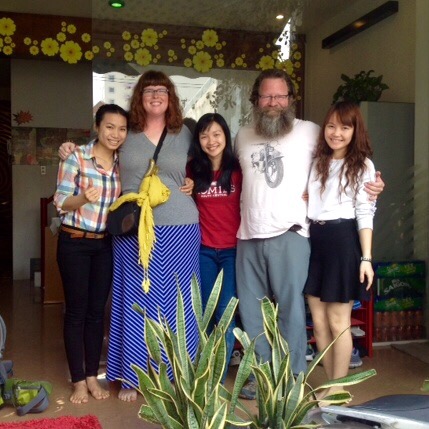 Becci and me along with (I-can’t-remeber-your-name-like-you-remembered-mine-and-I’m-so-sorry, “Snow”, and “Twin”. They are the tiniest and most adorable people of all time. Each weighs approximately as much as a well-fed housecat.
Becci and me along with (I-can’t-remeber-your-name-like-you-remembered-mine-and-I’m-so-sorry, “Snow”, and “Twin”. They are the tiniest and most adorable people of all time. Each weighs approximately as much as a well-fed housecat.
As has been the case throughout our visit to Vietnam, I have been called “Uncle Ho” and “Happy Buddha” a bunch of times. The “Uncle Ho” bit comes with beard stroking. The “Happy Buddha” reference is always accompanied with a tummy pat. When Twin patted my rock hard abs and called me “Happy Buddha”, she also commented “no more beer for you!”. Sorry, Twin, I’m having another beer. We’re at the beach!
After our three day beach adventure ended, and we said goodbye to the tiny fairy women of the Mozjo Inn, we set our sites on Ho Chi Minh City (formerly, Saigon). Having racked up a few frequent-flier points over the last year, we decided to cash in a few of those and get to Ho Chi Minh City in one hour instead of the eight it would have taken by train.
During our first night in Saigon, we decided to go hit the night market. We chowed down on some delicious sizzlin’ BBQ, and then worked our way up to the Sheraton bar for a night view of the city.
 Downtown Ho Chi Minh City, seen from the balcony bar at the Sheraton. They make a pretty good Long Island Iced Tea up there, but ya pay for the view. Totally worth it though. In one direction was a beautiful city, and in the other, a beautiful woman; my life is way better than I deserve.
Downtown Ho Chi Minh City, seen from the balcony bar at the Sheraton. They make a pretty good Long Island Iced Tea up there, but ya pay for the view. Totally worth it though. In one direction was a beautiful city, and in the other, a beautiful woman; my life is way better than I deserve.
 Dining on beef barbecue at downtown Saigon’s night market.
Dining on beef barbecue at downtown Saigon’s night market.
Speaking of the Sheraton, I should point out that during our entire time in Vietnam…in small towns and in big city Hanoi…we encountered no western stores. There are no Starbucks, no Burger Kings, no Tescos or Walgreens. Everything so far has been mom and pop stores, even in Hanoi. Only in Ho Chi Minh City (HCMC) did we encounter anything that seemed remotely western, observing one (and for a change, only one) Starbucks, a Pizza Hut, a Burger King, a Sony store, and oddly, a Baskin Robbins. There were even a few Circle K’s.
The next day in HCMC was a big one, and we started reasonably early. I woke Becci up playing Year of the Cat, which has become a bizarre tradition on this trip. It’s a good song ya’ll…and one that didn’t even exist in her musical world until I sang it one morning a few weeks ago. She was like…”what the hell are you singing….that’s not a real song…you are making that up!”. Nope, it’s for real, and you can enjoy it for yourselves here. Go ahead, I’ll wait.
It’s almost Tet (Chinese New Year), which is a huge holiday here in Vietnam. After the new year, it’ll be the year of the goat. The Tet holiday has been described as a combination of Christmas, Thanksgiving, and your birthday rolled into one. Unfortunately, we will be in Siem Reap when it actually happens, and Tet isn’t such a big deal in Cambodia. But we have gotten a sense of how big a deal this is in Vietnam over the last few weeks. We have seen Kumquat trees being sold in every city that we have visited, and in Saigon / HCMC we saw lots of flowers being sold as well.
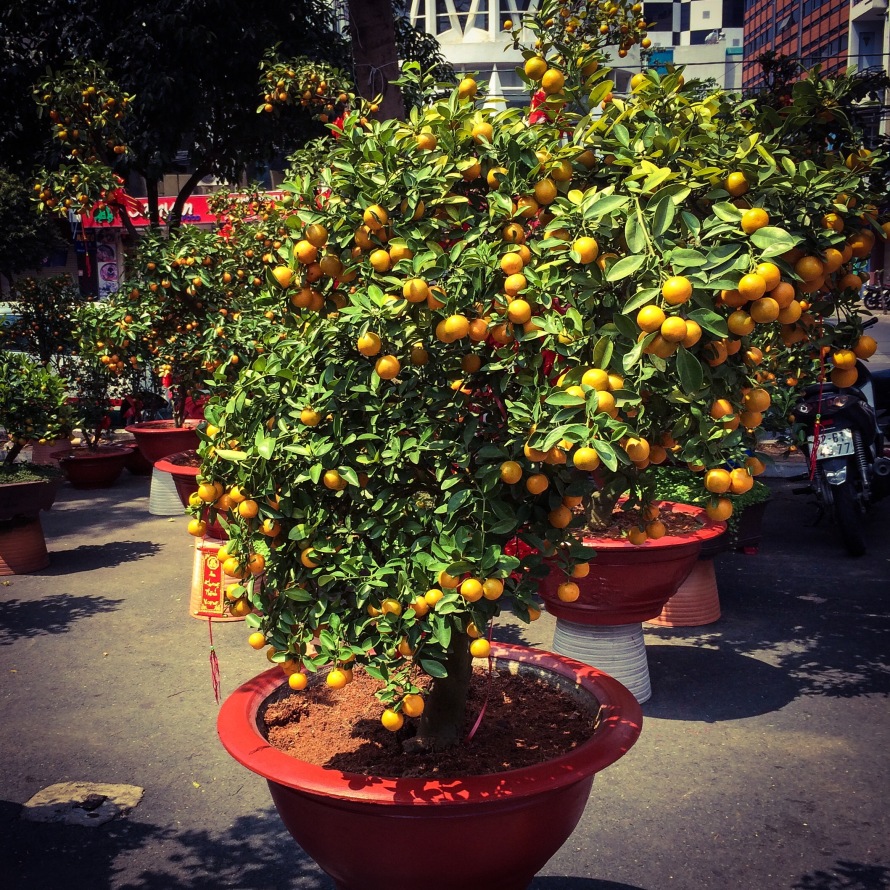 Kumquat trees. These are sold for Tet. You can’t believe how many of these we have seen in Hanoi and Ho Chi Minh City strapped to the back of a scooter as it raced through the crowded streets of these cities.
Kumquat trees. These are sold for Tet. You can’t believe how many of these we have seen in Hanoi and Ho Chi Minh City strapped to the back of a scooter as it raced through the crowded streets of these cities.
 As we walked past the vendors selling trees and flowers for the huge Tet holiday which occurs in a few days, Becci turned to me and said “this would be us; last-minute-buying our Tet trees!”
As we walked past the vendors selling trees and flowers for the huge Tet holiday which occurs in a few days, Becci turned to me and said “this would be us; last-minute-buying our Tet trees!”
There’s a little Indian restaurant a couple of doors down in the alley where our hotel is in HCMC. We had noticed that it was packed every time we went past, so we decided to stop in there and grab a little chow. I had a chicken vindaloo, and Becci worked on some chicken masala. It was good eatin’.
Fortified, we worked our way sluggishly toward our main objective for the day, the War Remnants Museum. This is a museum dedicated to the war that we in the U.S. call the Vietnam War. It’s known in Vietnam as the Second Indochina War or more pointedly, the War of American Aggression.
 Boeing CH-47 Chinook helicopter. This aircraft is an American twin-engine, tandem rotor heavy-lift helicopter. Its primary roles are troop movement, artillery placement, and battlefield resupply. Although these aircraft have been in production for over 50 years, the Chinook is still manufactured today.
Boeing CH-47 Chinook helicopter. This aircraft is an American twin-engine, tandem rotor heavy-lift helicopter. Its primary roles are troop movement, artillery placement, and battlefield resupply. Although these aircraft have been in production for over 50 years, the Chinook is still manufactured today.
 Tread from a captured tank. I neglected to identify the model.
Tread from a captured tank. I neglected to identify the model.
There are a few captured U.S. weapons outside the museum, including tanks, planes, and helicopters. These are great fun to look at and admire, as achievements of what can be built; they are wonderfully-engineered destruction / death machines; they are on a certain level simply fun toys for people to look at. Would I like to have them protecting me if trouble comes a-knockin’? Yessir.
Of course, it is hard to look at them only in this way. The longer these weapons are considered, the more time one has to think about the men and women who operated them, and what their lives in combat were like. How were these weapons obtained? Did their young occupants die serving their country? Did they die during torture after being captured? And of course, to imagine how these weapons were used in war against the North Vietnamese Army, against the Viet Cong, and against the Vietnamese non-combatants who were sometimes caught in the crossfire.
 M107 – 175mm gun. Heavy artillery.
M107 – 175mm gun. Heavy artillery.
The War Remnants Museum in Ho Chi Minh City is not particularly slick or creative, but it is effective at conveying it’s sad and disturbing message. Becci and I have visited many museums and war memorials during our travels over the last year. The narrative has always favored the British, the U.S., the French, the Australians, in contrast to the horrors put unto all of those valiant countries and their warriors by the Germans and the Japanese. Until today. Today, the U.S. was the bad guy.
In Vietnamese war memorials that we have visited, including the War Remnants Museum, the U.S. is the offending, invading, oppressive, cruel enemy to be resisted and overthrown. Although I didn’t learn much in this museum that I didn’t know already, it is jarring to see your country portrayed as the bad guy. We weren’t just the opponent, we were the oppressive, cruel, despised, mother-killing, baby-raping enemy. And to really bring it home, despite some of the spin that is occurring here (for example, omission of all references to cruel tactics and methods used by the Viet Cong), the things that are represented in this museum did happen. The horrors and atrocities documented are real, and they were performed by Americans operating under the direction of the United States government.
We need not go into the history or rationale for the Vietnam War; that’s a big topic that’s beyond my current abilities and beyond the scope of this blog. What we can say and what we do know is that the basic rationale for the war has proven historically to be invalid; that is to say, Communism did not spread like wildfire in the wake of the conversion of South Vietnam to Communism when it was “united” with North Vietnam at the conclusion of the war. Communism spread into South Vietnam, and into Cambodia (in retrospect, US action made the rise of the Khmer Rouge in Cambodia more, not less likely), and that’s as far as the dominos fell. As predicted, it was horrible for the people in South Vietnam…for a while. Today, as a visitor to this Socialist country, commerce and the free market seem alive and well. Today, there are far more small businesses per capita in Vietnam than in the U.S. Every family seems to own a small shop or restaurant. And the rest of the world is pretty much just fine and free of communist oppression as well. Communism didn’t run rampant in the wake of Vietnamese unification.
The War Remnants Museum pulls few punches. The exhibits inside, which mostly consist of photographic displays, are tough. The first one we encountered documented how protesters in virtually every country in the world, including many protesters in the United States, loudly and visibly objected to U.S. involvement in Vietnam’s war. A number immolated themselves. Although some governments nominally supported U.S. action, there were huge segments of people in each country that did not.
Further into the museum, there are a couple of exhibits focusing on American war crimes, which document in words and photographs a number of stories about the bombing and shooting of Vietnamese civilians. Generally, the rationale for U.S. soldiers doing this was that these villagers were clandestinely supporting the Viet Cong: their torture was interrogation; their killing was the execution of spies. Sickeningly, that sounds a whole lot like what the KGB would say, or the S.S., or the Khmer Rouge. Whole villages were bombed and burned, and their inhabitants…men, women, and children…were often killed in bombings or in some cases, shot by soldiers. One story we saw documented described three pre-teen children, found hidden by their grandfather in a well, who were shot by U.S. soldiers. Another story described an underground tunnel where villagers had hidden themselves. Thinking that they were VC guerillas, the tunnel was gassed.
The next large exhibit that we encountered is dedicated to the fallout from Agent Orange. It’s brutal, containing photo after photo after photo of horribly deformed people, trying to live their lives.
Agent Orange is a code name for a chemical defoliant that was used heavily during the war. The defoliant contained an active chemical agent that turns out to be super bad for people who come into contact with it. Thus named because of the orange barrels that it was shipped in, this defoliant contains an extremely toxic dioxin compound that can be used to strip forests; that capability came in handy for U.S. military operations. What operators probably didn’t know, and certainly didn’t care about at the time, is that this stuff unzips yer DNA and creates offspring with physical deformities that you wouldn’t and couldn’t think up in your worst nightmare.
Well, to be fair, research papers discussing birth defects associated with these specific chemicals were published as early as 1957…so all of the decision-makers should have known better. So I guess it’s unfair to say they didn’t know; it’s probably better to say that they just didn’t give a shit. That’s our government at work folks, doing what they thought is best (for whom?), on our behalf.
I didn’t include any photos from the Agent Orange exhibit out of respect for the victims. You can look that stuff up in you want. It’s shocking, and no matter what you have seen in your life, you will be stunned and sickened. Becci and I actually saw some Agent Orange kids, all grown up now, lurching and crawling around the streets of Hanoi and Saigon, begging for money. Hundreds of thousands of people, or maybe more, in Vietnam and the U.S. have been affected by U.S. use of Agent Orange during the war. The Vietnamese government says that three million Vietnamese people have suffered some type of adverse health affect directly related to the use of Agent Orange. Soldiers on both sides, as well, as Vietnamese civilians, have died of various types of cancer. Tens of thousands of babies in the Vietnam and in the U.S. have died stillborn or experienced significant, life-changing birth defects, including loss of arms and / or legs; siamese twins; enlarged, reduced, or missing organs; loss of essential brain functions. We saw photos of twins that were conjoined in opposite directions at the waist (neither had a lower half); we saw an exhibit on a girl who had to live in a cage because she tried to eat everything she could reach. We saw innumerable photos of people with tiny or non-existent limbs, including no limbs at all.
We walked on.
The best exhibit in the museum is one that documents the war firsthand from the perspective of war journalists on both sides. Quite a few of these photojournalists did not survive the war. There were a couple of photographs that literally said in the caption something along the lines of “this is the last photograph this journalist ever took”.
Photos in this exhibit included work from Gilles Caron, Kent Potter, Sergio Ortiz, Kyoichi Sawada, Larry Burrows, Robert J. Ellison, Terry Khoo, Luong Nghia Dung, Pham Van Khuong, Dana Stone, Henri Huet, Tazio Ichinose, Michel Laurent, Horst Faas, Hiromichi Mine, and others. All of the big shots that you have seen were there, including “naked napalm girl” and “young spy being shot in the head”. But there were tons of other amazing photographs in this display. Here are a few of the photos that were included in the exhibit. I would like to recognize and apologize for the fact that I have not below acknowledged each photograph’s author.
I watched the film Paths of Glory on a recent long overnight train ride. This film, directed by Stanley Kubrick, was his fourth film and came out in 1957. It was right before Spartacus. It’s been described to me by my friend as “the greatest war movie ever made”…and it’s Kubrick…and it’s a war film. And yet I had until now neglected to see it.
It is a great and very watchable film. Even though it was early in Stanley Kubrick’s work, it still has the unmistakable look of a Kubrick film. The story is told efficiently, and acted sublimely and directly by a cast filled with unforgettable faces, including Kirk Douglas’. As Kubrick always did, he filled the film with dramatic camera angles and lighting, and somehow got his actors to deliver straightforward, career-best acting performances.
Somewhat like Dr. Stangelove, which came seven years later, this film is anti-war and anti-authoritarian, showing the absurd and illogical decisions that can be made during war for all-too-human reasons. Paths of Glory is not farcical or whimsical or funny, as Dr. Stangelove is. There are no funny moments in this film, only darkly bitter ones.
Set in World War I, Paths of Glory explores topics that are relevant to all wars: how leaders see soldier’s lives as a commodity to spend in order to achieve an objective; how individuals approach their certain, impending deaths. Like the War Remnants museum, the film pulls no punches.
This film, like the War Remnants Museum, is a reminder of the unintended consequences of war. One might even say…the unexpected consequences of war. That’s something I think about every time we visit a museum or memorial exploring the aftermath of a war…the unexpected consequences of war. The use of the word unexpected seems somehow wrong to use here though…since every war has unexpected, bad consequences, should we not come to expect them? Even though we don’t know what they will be, can we not begin to understand that some number of horrible unknown outcomes will occur each time we decide to use military force?
I’m not one of those people who thinks that violence never solves anything. If violence did not solve problems, there would be no armies and no police and there never would have been. But…the use of violence and war must be adequately weighed. Violence and war must truly become the last solution to resolving conflict. It must be understood to be the most costly way to resolve conflict. War cannot be undertaken as lightly as it has been in the Vietnam conflict, in the Afganistan conflict, and in the Second Gulf war. War must once again become the thing that the “bad” guys start and the “good” guys finish, when all other opportunities have been exhausted. Why? Because of the vast, significant, all-too-human “unexpected” consequences of all wars. The most staunchly hawkish people that I know, who all served in the U.S. military, can each tell story after story of unexpected, wasted lives lost to war.
Wars do waste human lives; not just those of the soldiers on both sides that were perhaps anticipated, but also all of those unexpected, unanticipated losses, like the hundreds of thousands (millions?) of lives lost or severely damaged by Agent Orange; like the hundreds of thousands of non-combatant civilians killed in Vietnam, Afghanistan, and Iraq. Like the Vietnamese kids, shot by soldiers that we rightly pity now and would also demonize if they were wearing S.S. or ISIL uniforms. Like the people we watched crawling through and begging in the streets of Hanoi and Ho Chi Minh City.









